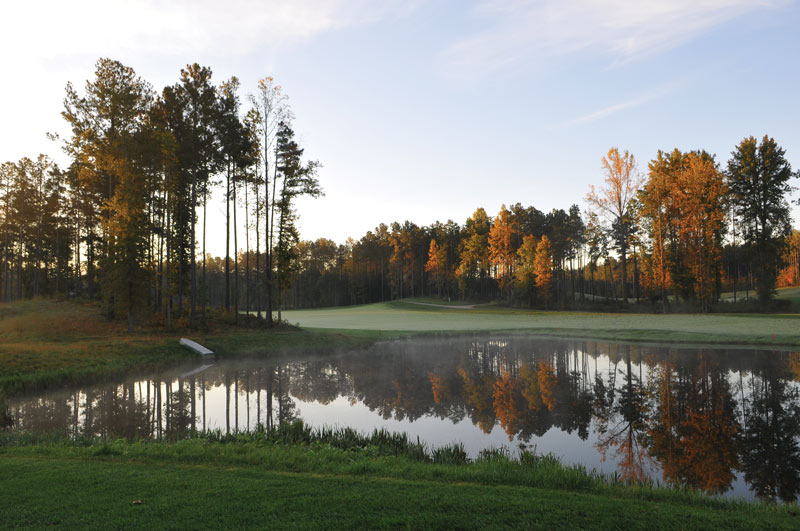
The buffer of vegetation along the edge of a pond at The Federal Club in Glen Allen, Va., furnishes a habitat for many desirable species of wildlife while also stabilizing the shoreline and improving the pond’s water quality. Seven-year GCSAA member Matthew Drayton is the superintendent at The Federal Club. Photo by Daryl Watkins/www.creativedogmedia.com
I became an avid golfer at age 13, and several years later, at 24, I began my career as a wildlife biologist. In the 36 years since, I have continued to pursue these two passions, even though they have at times seemed to be at odds with each other. Today, it is impossible for me to play a round of golf without noticing the wildlife and the habitats present on and around the golf course. It is also difficult for me not to think about the plants and animals that could, should or should not be present at many of the courses I visit.
I suppose that as a wildlife biologist, I could bemoan the negative impacts that the construction and management of many golf courses have had on wildlife. And I suppose that as a golfer, I could rail against the damage that some insects, birds and mammals do to a golf course. But I would rather focus on all the opportunities golf courses have to enhance wildlife habitat while reducing maintenance costs and improving aesthetics for the enjoyment of golfers — opportunities that are present on most every course. Here are four golf course maintenance strategies that are fundamental to fostering and caring for wildlife habitat, and that would be a good launching point for superintendents looking to get started with more environmentally beneficial management.
1. Eliminate or reduce mowing of areas that are not normally in play
This may seem intuitive, but many courses still regularly mow these areas. Why? Because they have always done it. Some benefits of decreased mowing are fairly obvious, such as lower fuel and labor costs, but reduced water use, reduced chemical use, reduced erosion and improved water quality — on and off the course — are also perks associated with this practice. These unmowed spaces can also provide cover and forage for wildlife. Maintaining or restoring native vegetation (native grasses, wildflowers, shrubs or trees) in these areas supports pollinators and other beneficial insects along with songbirds, quail and turkey.
2. Expand water hazards to include a buffer
This border of unmowed or at least rough-high vegetation should be as wide as the length of at least one golf driver. The taller growth will provide a haven for wildlife and slow the flow of runoff, and the vegetation will have a chance to absorb fertilizer and other chemicals before they reach the water. The edging will also help reduce erosion and sedimentation. Creating a buffer may involve moving the stakes or hazard lines, depending on the circumstances. Fish, amphibians, bats, ducks, wading birds and a variety of beneficial insects will be the main beneficiaries of this simple adjustment.
3. Refine chemical use
Most modern-day golf course superintendents are mindful of this, as herbicides, fungicides, fertilizers and pesticides — and the labor and equipment required to apply them — are major components of the budget. To be both a cost- and wildlife-conscious chemical user, read product labels carefully, and ensure you’re using the minimum amount of chemical required to accomplish the management goal. Incorporating integrated pest management (IPM) practices, including monitoring, can further reduce chemical use while increasing treatment effectiveness. Many of the chemicals used in golf course maintenance tend to move downwind, downhill (via surface runoff or through the soil) and downstream, so rethinking application rates (that is, reducing them on the downhill or downwind portion of a green or fairway) can also ease impacts to both wildlife and the bottom line.
4. Monitor non-native invasive species of animals and plants
While superintendents are quite aware of the agronomic problems that can be caused on the fairways and greens by pests and diseases, not all are aware of the problems that can be caused from non-native invasive plants and animals. Here in the Midwest, for instance, bush honeysuckle, Canada thistle, johnsongrass, Sudangrass and English ivy are common on many golf courses. Eurasian watermilfoil, hydrilla, Asian carp, goldfish and koi can be found in numerous ponds. The first step is to identify these flora and fauna. County and state weed boards, natural resource departments and conservation agencies will have lists of such species on their websites, usually with photos. Like chemicals, many invasive species tend to move downwind and downstream, so golf courses can be the recipient of these problems from adjoining properties, and can also become the source of them. To more effectively deal with invasive species, superintendents should think beyond the golf course and consider their place in the larger landscape/watershed, and from there work cooperatively with neighbors, watershed associations, non-government organizations, and state and federal agencies.
Wedge Watkins is a wildlife biologist and Midwest region pollinator coordinator with the U.S. Fish and Wildlife Service. He is based at Big Muddy National Fish and Wildlife Refuge in Missouri.